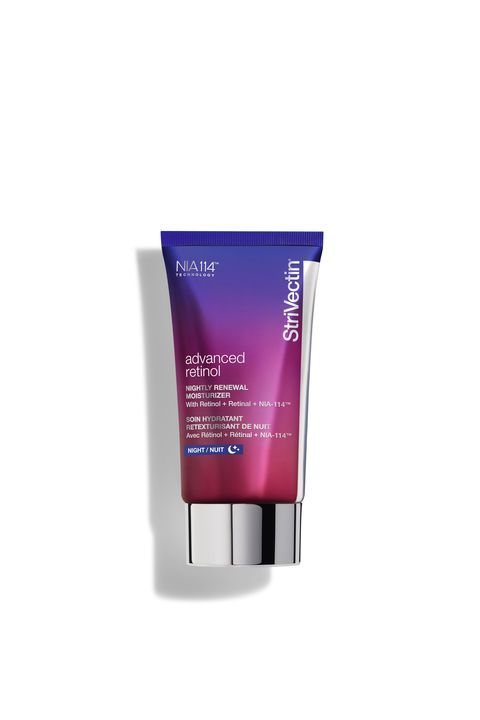Products You May Like
For millennia, people have been enchanted by the belief of a hidden fountain of youth. While explorers never found such a place, scientists got pretty close to the spirit of the idea when they discovered that vitamin A derivatives, known as retinoids, can help speed up skin’s natural cellular turnover process, helping to fade the visible appearance of fine lines and wrinkles.
You’ve likely heard the term “prescription retinoids,” or read about the iconic anti-aging ingredient retinol. But what about retinal? This cousin of retinol can potentially deliver the results of an Rx from your derm, but you can snag it online at Strivectin.com—more on that later. Here, we break down exactly how retinal works, what makes it stand apart from others in its vitamin A cohort, and ingredients that make retinal work even more effectively.
What do retinoids do?
To understand why retinal is such a superstar, you’ll need to get acquainted with retinoids. Vitamin A derivatives actually change cellular function and reduce inflammation, leading to all those skincare perks you’ve heard of, like smoother-looking skin, smaller-looking pores, and an overall clearer, brighter, and healthier-looking complexion. It makes sense, then, that (aside from SPF) topical retinoids are dermatologists’ most frequent recommendation for better skin. “Their ability to dramatically improve the appearance of the skin while altering its function into a healthier state is second to none,” explains Dr. Matthew Elias, a board-certified dermatologist in Fort Lauderdale, Florida.
Why is retinal so effective?
But the only form of vitamin A that your body can recognize is the prescription-strength retinoic acid. “Retinoic acid is the active form [of vitamin A] in the skin, and is known by the common name Retin-A or tretinoin,” says Dr. Elias.
When you apply retinol, your body must convert it to retinaldehyde, or retinal, and then finally to retinoic acid so your skin recognizes it—but that conversion process weakens the ingredient’s overall efficacy. That’s why retinal deserves more credit. “Retinal is the first step retinol undergoes in its transformation to retinoic acid,” says Dr. Elias. “By using topical retinal, you may be able to see faster results with your topical treatment, as one step in the conversion process has already happened.”
That’s not all: In a study comparing .05% retinal and .05% retinoic acid, retinal was shown to be just as effective as the prescription-strength ingredient in reducing signs of photoaging, all while being significantly less irritating to the skin. Retinoids, especially in their prescription form, are known to sensitize skin, particularly when the user applies too much, too frequently (typically, vitamin A should be applied once or twice a week to start, then more as the skin adjusts—but we’ll be back to this shortly). “Retinoid dermatitis is a common, albeit temporary, side effect of topical retinoids and can lead to dryness, flaking and peeling and itching,” explains Dr. Elias. “It is typically short-lived—approximately two weeks — although there are some patients who can experience longer-term retinoid dermatitis of up to three months.”
What should be paired with retinal?
Selecting the best ingredients for a formula is everything when it comes to efficacy and skin comfort. When looking for skincare products with retinoids, you should seek out a formula that contains not just those potent active ingredients, but gentler ingredients that help soothe skin while supporting the transformative powers of actives. Doing so will help significantly cut down on that retinoid adjustment period, if not eliminate it altogether.
Perhaps the most beneficial ingredient to pair with vitamin A derivatives like retinal and retinol is myristyl nicotinate. This ingredient, also known as NIA-114™, is a patented form of niacin exclusive to the iconic skincare brand StriVectin. A clinical study from 2007 shows that NIA-114™ dramatically alters the dermatitis side effects of topical retinoids, explains Dr. Elias, making the skin more comfortable while still reaping the rewards of vitamin A.
Another ingredient is peptides, specifically the peptide acetyl hexapeptide-8. Studies have found that this peptide boasts skin-smoothing, nourishing, and hydrating properties as well as the ability to improve the appearance of skin redness—making it ideal for pairing with vitamin A. Also noteworthy is beta-glucan, a sugar typically derived from oats that helps soothe sensitive skin while providing free radical defense.
I want to try it—where do I start?
Knowing that retinol sensitivity is often a reason why people are wary of using retinoids — but that the transformative effects of retinoids can’t be beat—the StriVectin team has launched a brand new night treatment, Advanced Retinol Nightly Renewal Moisturizer, which has been formulated with both retinol and retinal for powerful results. However, because of the synergistic blend of ingredients, the cream can be used every single night from the very first application, even if you’ve never used retinol before. StriVectin uses a proprietary micro-sponge technology, a unique delivery system that helps evenly distribute the ingredients across the skin and promotes slow, steady absorption for comfortable results.
On a personal note, as an editor who has both figuratively and literally been burned by retinoids in the past, I have been very pleasantly surprised by how comfortable StriVectin’s formula feels on my skin. It’s lightweight yet nourishing—the perfect combination for a moisturizer, in my opinion. As you massage Advanced Retinol Nightly Renewal Moisturizer into your skin, you get a whiff of its subtle, laundry-fresh fragrance, which fades and leaves a semi-matte radiant finish in its wake. The formula makes my skin feel very soft and smooth, and I’m always surprised to see how radiant I look (as opposed to tired and sallow) upon waking up the next morning.
Now that you, a skincare adventurer, know how incredible retinal is, there’s only one step left: Using it to help minimize your signs of aging.
This content is created and maintained by a third party, and imported onto this page to help users provide their email addresses. You may be able to find more information about this and similar content at piano.io


